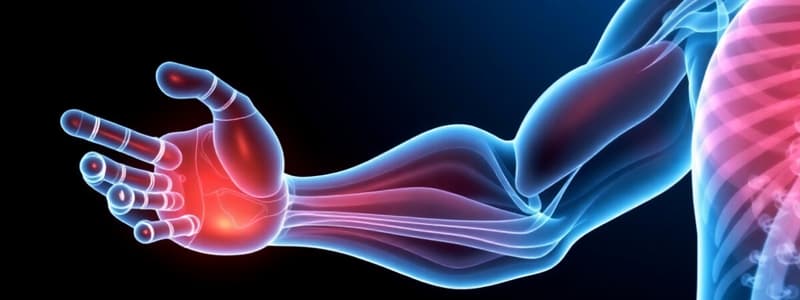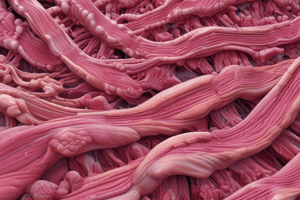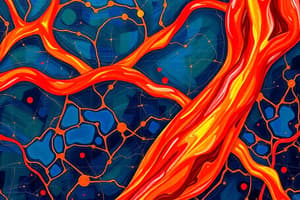Podcast
Questions and Answers
What is the main function of dystrophin in muscle cells?
What is the main function of dystrophin in muscle cells?
Which of the following is a potential consequence of anabolic steroid use?
Which of the following is a potential consequence of anabolic steroid use?
What is the mechanism by which anabolic steroids increase muscle mass?
What is the mechanism by which anabolic steroids increase muscle mass?
What is the primary reason why Duchenne Muscular Dystrophy (DMD) is more common in boys?
What is the primary reason why Duchenne Muscular Dystrophy (DMD) is more common in boys?
Signup and view all the answers
How does muscle hypertrophy differ from atrophy?
How does muscle hypertrophy differ from atrophy?
Signup and view all the answers
During high intensity exercise, which substrate is primarily used for energy?
During high intensity exercise, which substrate is primarily used for energy?
Signup and view all the answers
Which of the following hormones does NOT directly promote the breakdown of triglycerides?
Which of the following hormones does NOT directly promote the breakdown of triglycerides?
Signup and view all the answers
What is the primary effect of the sympathetic nervous system on insulin secretion during exercise?
What is the primary effect of the sympathetic nervous system on insulin secretion during exercise?
Signup and view all the answers
What determines the precision of a movement, in terms of motor units?
What determines the precision of a movement, in terms of motor units?
Signup and view all the answers
What is the main function of GLUT4 during exercise?
What is the main function of GLUT4 during exercise?
Signup and view all the answers
What is the primary role of creatine phosphate in skeletal muscle contraction?
What is the primary role of creatine phosphate in skeletal muscle contraction?
Signup and view all the answers
During muscle contraction, what is the role of calcium ions ($Ca^{2+}$)?
During muscle contraction, what is the role of calcium ions ($Ca^{2+}$)?
Signup and view all the answers
How does aerobic respiration in muscle cells compare to anaerobic respiration in terms of ATP production from 1 molecule of glucose?
How does aerobic respiration in muscle cells compare to anaerobic respiration in terms of ATP production from 1 molecule of glucose?
Signup and view all the answers
Which of the following processes is directly powered by ATP during muscle contraction?
Which of the following processes is directly powered by ATP during muscle contraction?
Signup and view all the answers
What molecules are required for muscle contraction?
What molecules are required for muscle contraction?
Signup and view all the answers
What occurs during multiple motor unit recruitment?
What occurs during multiple motor unit recruitment?
Signup and view all the answers
Which of the following is an example of an isometric contraction?
Which of the following is an example of an isometric contraction?
Signup and view all the answers
How do slow twitch (type I) muscle fibers primarily generate energy?
How do slow twitch (type I) muscle fibers primarily generate energy?
Signup and view all the answers
What is the main function of muscle spindles?
What is the main function of muscle spindles?
Signup and view all the answers
What type of muscle fibers fatigue more quickly?
What type of muscle fibers fatigue more quickly?
Signup and view all the answers
What role do Golgi tendon organs (GTO) play in muscle contraction?
What role do Golgi tendon organs (GTO) play in muscle contraction?
Signup and view all the answers
What is the primary characteristic of concentric contractions?
What is the primary characteristic of concentric contractions?
Signup and view all the answers
What is proprioception?
What is proprioception?
Signup and view all the answers
Which of the following best describes the initial response to muscle spindle activation?
Which of the following best describes the initial response to muscle spindle activation?
Signup and view all the answers
Which condition refers to diseases of skeletal muscle?
Which condition refers to diseases of skeletal muscle?
Signup and view all the answers
Flashcards
ATP in muscle contraction
ATP in muscle contraction
The molecule that provides energy for muscle contraction.
Creatine Phosphate
Creatine Phosphate
A protein stored in skeletal muscle that can quickly donate a phosphate to ADP to replenish ATP stores.
Anaerobic Metabolism
Anaerobic Metabolism
A compound that provides energy for muscle contraction in the absence of oxygen, resulting in the production of lactate.
Aerobic Metabolism
Aerobic Metabolism
Signup and view all the flashcards
TCA Cycle
TCA Cycle
Signup and view all the flashcards
Energy Source Ratio
Energy Source Ratio
Signup and view all the flashcards
Hormonal Response to Exercise
Hormonal Response to Exercise
Signup and view all the flashcards
Hormonal Fat Breakdown
Hormonal Fat Breakdown
Signup and view all the flashcards
Hormonal Glucose Release
Hormonal Glucose Release
Signup and view all the flashcards
Motor Unit
Motor Unit
Signup and view all the flashcards
Hypertrophy
Hypertrophy
Signup and view all the flashcards
Atrophy
Atrophy
Signup and view all the flashcards
Duchenne Muscular Dystrophy (DMD)
Duchenne Muscular Dystrophy (DMD)
Signup and view all the flashcards
Anabolic Steroids
Anabolic Steroids
Signup and view all the flashcards
Muscle Protein Synthesis
Muscle Protein Synthesis
Signup and view all the flashcards
What is a motor unit?
What is a motor unit?
Signup and view all the flashcards
What is multiple motor unit recruitment?
What is multiple motor unit recruitment?
Signup and view all the flashcards
What is an isometric muscle contraction?
What is an isometric muscle contraction?
Signup and view all the flashcards
What is an eccentric muscle contraction?
What is an eccentric muscle contraction?
Signup and view all the flashcards
What is a concentric muscle contraction?
What is a concentric muscle contraction?
Signup and view all the flashcards
What is proprioception?
What is proprioception?
Signup and view all the flashcards
What is a muscle spindle?
What is a muscle spindle?
Signup and view all the flashcards
What is the stretch reflex?
What is the stretch reflex?
Signup and view all the flashcards
What is a Golgi tendon organ (GTO)?
What is a Golgi tendon organ (GTO)?
Signup and view all the flashcards
What is the Golgi tendon reflex?
What is the Golgi tendon reflex?
Signup and view all the flashcards
Study Notes
Muscle Contraction Overview
- Muscle contraction is a complex process involving various mechanisms, energy sources, hormones, and muscle fiber types.
- Skeletal muscle makes up 30-40% of the body's mass.
- It's used for movement, breathing, and posture.
- Skeletal muscles use ATP (adenosine triphosphate) for energy, and changes in Ca2+ concentration initiate contraction.
Muscle Contraction Mechanisms
- Myosin (thick filament) and actin (thin filament) interact to produce muscle contraction.
- The Ca2+ binding to troponin exposes myosin binding sites on actin, allowing the myosin heads to bind, pull the thin filament over the thick filament.
- ATP is crucial for the power stroke, detachment, and resetting of the myosin head.
ATP Production and Sources
- Creatine phosphate is the most abundant source of ATP in skeletal muscle.
- It rapidly donates a phosphate to ADP to regenerate ATP.
- Additional ATP comes from glycogen stores, anaerobically (forming lactate), and aerobically (through the TCA cycle).
- During aerobic oxidation, 32 molecules of ATP are produced per glucose molecule, compared to 2 molecules in anaerobic conditions.
Muscle Fiber Types
- Slow twitch (type I, red) fibers: contract slowly, don't fatigue easily, rich in myoglobin and mitochondria, rely on aerobic energy production.
- Fast twitch (type II, white) fibers: contract quickly, fatigue more quickly, use anaerobic energy production, have a high SR (sarcoplasmic reticulum) concentration for Ca2+ handling.
Motor Units
- A motor unit consists of a motor neuron and all the skeletal muscle fibers it innervates.
- Groups of motor units work together (motor pool) for coordinated movement.
- Small motor units allow precise movements (e.g., eye muscles).
- Large motor units enable powerful movements (e.g., quadriceps).
- Motor unit recruitment happens in order of size (small to large) from the smallest muscle fiber diameter to the largest when strength of contraction is needed from the body
Whole Muscle Contraction Types
- Isometric: Muscle length stays constant; tension develops, but no movement occurs (e.g., pushing against a wall).
- Isotonic: Muscle changes length during contraction; either concentric (muscle shortens) or eccentric (muscle lengthens) (e.g., lifting or lowering a dumbbell).
Muscle Proprioception and Reflexes
- Proprioception is the sense of body position and movement.
- Proprioceptors are specialized sensory receptors in muscles, tendons, joints, and skin.
- Muscle spindles detect muscle stretch.
- Golgi tendon organs (GTOs) respond to muscle tension.
- These reflexes are critical for automatic adjustments to maintain posture and movement.
- The stretch reflex (muscle spindle) protects against abrupt muscle lengthening, while the Golgi tendon reflex (inverse myotatic) protects against excessive muscle tension.
Clinical Relevance and Pathology
- Neuromuscular diseases, such as myopathies (muscle diseases) and neuropathies (nerve diseases), can affect muscle function.
- Movement disorders (e.g., Parkinson's, Huntington's) can have a neurological basis.
- Muscle hypertrophy and atrophy are changes in muscle size due to factors such as exercise, inactivity, hormones, and aging.
- Some genetic conditions, like Duchenne Muscular Dystrophy, are characterized by a defect in the muscle protein dystrophin.
Hormones and Muscle Function
- Hormones like cortisol, epinephrine, and growth hormone increase during exercise.
- They can affect energy metabolism and promote glycogen breakdown, converting triglycerides to fatty acids.
- Blood glucose will increase but insulin production will suppress. Muscles need glucose so there will be an increase in Glut4 receptors. Increased receptors, increase glucose uptake.
Hormonal Changes during Exercise
- Cortisol, epinephrine, and growth hormone increase during exercise.
- They promote the conversion of triglycerides into glycerol and fatty acids, thereby increasing the availability of energy.
- Glucagon increases blood glucose by promoting the conversion of liver glycogen to glucose.
- Insulin secretion is suppressed by the sympathetic nervous system, enhancing glucose uptake by muscle tissue.
Clinical Example: Steroids in Sport
- Anabolic steroids increase muscle mass and strength by affecting gene transcription.
- However, they can have negative side effects, including behavioral changes and cardiovascular complications.
Clinical Example: Duchenne Muscular Dystrophy
- Duchenne Muscular Dystrophy is an X-linked recessive genetic disorder, primarily affecting boys.
- It's characterized by a defect in the muscle protein dystrophin, impacting muscle fiber integrity.
- This leads to progressive muscle weakness and decline in life expectancy.
Studying That Suits You
Use AI to generate personalized quizzes and flashcards to suit your learning preferences.
Related Documents
Description
Explore the intricate processes of muscle contraction, focusing on the interaction between myosin and actin, energy sources like ATP, and the role of calcium ions. This quiz will enhance your understanding of skeletal muscle physiology and energy production methods. Perfect for students studying muscle biology or physiology.


